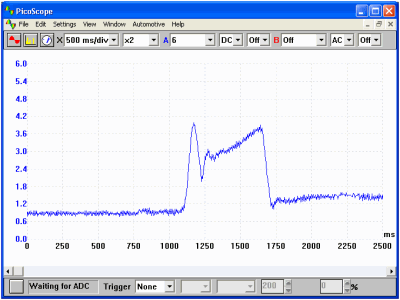 |
This is a good waveform |

 View larger image View larger image
 Download this waveform file for use with PicoScope Download this waveform file for use with PicoScope
Air Flow Meter (Air Vane) Waveform Notes
The voltage output from the internal track of the Air Flow Meter (AFM) should be linear to flap movement, this can be measured on an oscilloscope and should look similar to the example shown.
The waveform should show approximately 1.0 volt when the engine is at idle, this voltage will rise as the engine is accelerated and will produce an initial peak. This peak is due to the natural inertia of the air vane and drops momentarily before the voltage is seen to rise again to a peak of approximately 4.0 to 4.5 volts. This voltage will however depend on ho hard the engine is accelerated so a lower voltage is not necessarily a fault within the AFM. On deceleration the voltage will drop sharply as the wiper arm, in contact with the carbon track, returns back to the idle position. This voltage may in some cases ‘dip’ below the initial voltage before returning to idle voltage. A gradual drop will be seen on an engine fitted with an idle speed control valve as this will slowly return the engine back to base idle as an anti-stall characteristic.
A time base of approximately 2 seconds plus is used, this enables the operator to view the AFM’s movement on one screen, from idle, through acceleration and back to idle again. The waveform should be clean with no ‘drop-out’ in the voltage, as this indicates a lack of electrical continuity. A good example of this is shown on the ‘Faulty 12 volt AFM’ example waveform. This is common on an AFM with a dirty or faulty carbon track. The problem will show as a ‘flat spot’ or hesitation when the vehicle is driven, this is a typical problem on vehicles with high mileage that have spent the majority of their working life with the throttle in one predominant position. The ‘hash’ on the waveform is due to the vacuum change from the induction pulses as the engine is running.
汽車診斷 | 汽車診斷儀 | 汽車故障診斷儀 | 汽車測試儀 | 汽車分析儀 | 汽車診斷示波器 | 汽車電路測試儀 | 汽車電路分析儀 | 發(fā)動機(jī)分析儀 | 發(fā)動機(jī)綜合分析儀 | 發(fā)動機(jī)檢測中心 | 點(diǎn)火分析儀 | 點(diǎn)火測試儀 | 汽車傳感器測試儀 | CAN總線示波器 | LIN總線示波器 | 汽車故障記錄儀 | 汽車傳感器分析儀 | 汽車檢測儀 | 噴油嘴測試儀 | 點(diǎn)火線圈測試儀 | 蓄電池測試儀 | 發(fā)電機(jī)測試儀 | 起動機(jī)測試儀 | ABS傳感器測試儀 | ECU測試儀 | ECM測試儀 | 進(jìn)氣真空/壓力測試儀 | 排氣壓力測試儀 | 汽車技術(shù)培訓(xùn) | 爆震傳感器測試儀 | 缺火測試儀 | 缺缸測試儀 | 線路測試儀 | 引出線 | 汽車數(shù)字示波器 | 真空傳感器 | 高壓感應(yīng)測試頭 | 無分電器點(diǎn)火測試頭 | 獨(dú)立點(diǎn)火(COP)感應(yīng)測試頭 | 漏電測試儀 | 氣缸相對壓縮測試 | 電腦測試儀 | 發(fā)動機(jī)控制器測試儀 | 泄漏測試儀 | 熒光檢漏 | 超聲波檢漏 | 汽車數(shù)字萬用表 | 電流鉗表 | 電流勾表 | 點(diǎn)火正時燈 |



